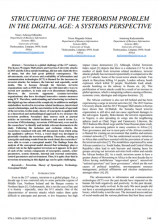Terrorism is a global challenge of the 21 st century. The Kenya Westgate Mall attack and Garrissa University attacks in 2015 and the Libya suicide bombings, did not only claim the lives of many, but also had great political consequences. The advancements, ease of access and availability of information and communication technologies (ICT) is blamed for the increases in terrorist attacks: for instance, the Internet and especially, social media. This is because through the Internet, terrorist organizations such as ISIS have come up with innovative ways to recruit new members, to train and even disseminate ideologies. However, the terrorist opponents (counter-terrorism organizations) also have developed innovative counter-measures using ICT. Therefore, understanding and structuring terrorism in this digital age has enhanced the complexity in addition to multiple stakeholders involved in terrorism related incidences, intertwined causal-relationships, and the uncertainties in the mode of operandi of the terrorists. In this study, theory of synergetics is applied both as a theoretical and methodological approach to try structure the terrorism problem. Secondary data sources such as journal articles on terrorism related incidences and search terms (i.e. terrorism AND technology, terrorism AND Internet), were used by the researchers’ to identify and include relevant documents in the study. Following the inclusion and exclusion criteria, the researchers remained with only 405 documents from which using the qualitative software Nvivo, a word cloud was developed to pictorially visualize the terrorism problem. Thereafter, relying on synergetics and using results from the word cloud, the researchers’ were able to create a conceptual model. The findings from the analysis of the conceptual model showed that technology plays a critical role in the fight against terrorism as it appears to be part of each of the various components of synergetics, namely, order parameters, system elements, internal and external constraints, control parameters and environment.
